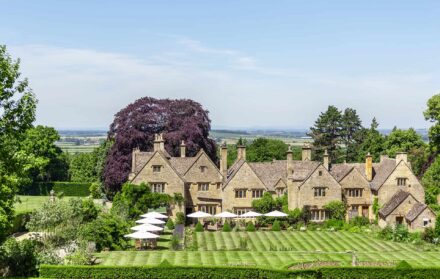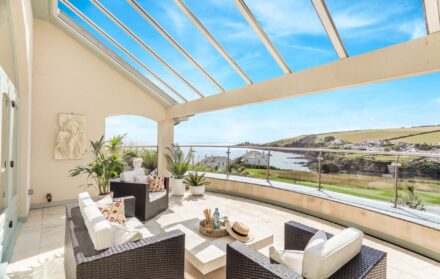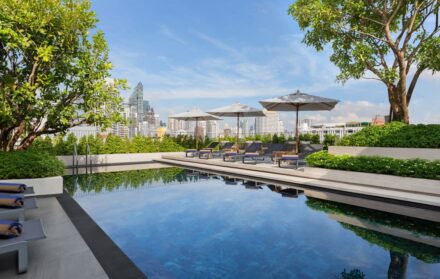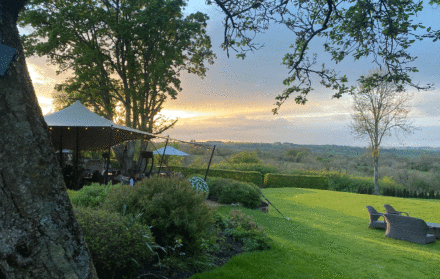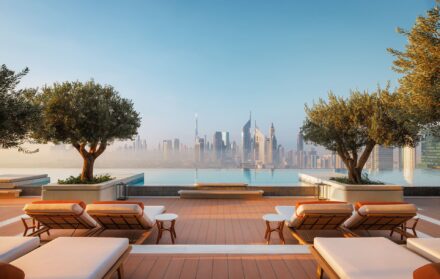The story of The OWO: How the Old War Office became London’s most luxurious development
As the Old War Office starts a new life as a five-star hotel and residences, we take a look back at it’s long history
If you run in the circles of prime property or hotels, or are just generally au fait with luxury goings-on in the capital, you’ll have heard of The OWO. Not only does the development represent hotel group Raffles’ first foray into the UK, as well as a milestone of the branded residence industry – it is also one of the biggest ticket and most heritage-rich London renovations of this century.
The OWO was home to the government’s War Office (later the Ministry of Defence) throughout the 20th century. Herbert Kitchener, Richard Haldane and Winston Churchill have strode its corridors, and nation-shaping decisions were made in its staterooms. But The OWO’s is a story that starts before the First World War, back in the time of Thomas Wolsey and Henry VIII. This is how a national bastion became the showpiece of one of the world’s wealthiest real estate magnates…
The early days of Whitehall
Whitehall, home to The OWO, has been a seat of power since the early medieval period. The area was dominated by royal palaces from 1060 and the Palace of Westminster, in particular, was a centre of government during the reign of Henry III.
In 1240, a house on the site of today’s OWO was sold to the Archbishop of York, and subsequently renamed York Place. Wolsey, a statesman and Catholic bishop, took up residence in 1514, embarking on a programme of expansion that would see the house become the largest and most modern in Westminster. Thus, when a fire broke out in the Palace of Westminster in 1512, Henry VIII turned his attention to York Place. He appropriated the whole area in 1536, forming the basis of the new Whitehall Palace (the name, first recorded in 1532, is taken from the white ashlar stone of Wolsey’s home).
Whitehall became the premier palace of the Tudors and Stuarts. However, in 1698, during the reign of William III, it was almost entirely destroyed by fire. The site was then used for official government buildings and, in 1721, the War Office was installed in one of these.
The modern War Office building
Whitehall remained the headquarters of Britain’s war activities for the next two centuries, with various iterations being built and demolished. The imposing feat of architecture that we see today, however, wasn’t erected until 1906, by which time the old building – or complex, rather, with a configuration more like adjoining houses with some of the staff stationed some distance away (so far that, in 1886, 164 of the 958 War Office officials were messengers) – was not fit for purpose. So much so, in fact, that a contemporary newspaper reported, ‘employment in the War Office, in consequence of the sickness and mortality attending it, should rank in point of danger at about the same level as an Ashantee campaign’. A solid one-star Glassdoor rating, then.
The new War Office was considered an architectural set piece that would prove the legitimacy of London as the capital of an empire. It was there to protect the Empire’s interests, and must therefore, symbolically, look the part. Some 26,000 tons of Portland stone was used in its construction, as well as 3,000 tons of York stone and 25 million bricks, at a total cost of £1.2 million (almost £123 million today). It was an Edwardian Baroque masterpiece with elaborate turrets, columns and statues, and a main façade composed of sumptuous arches and rusticated masonry.
The War Office was also huge, with more than 1,000 rooms linked by two-and-a-half miles of corridors – to answer the logistical question of communications, Boy Scouts were employed as bike-riding messengers. The scale was still a nightmare to navigate, however: when Sir Charles Callwell took up the post of Director of Military Operations in 1914, he reported that, over three consecutive days, he sent out messengers to find a particular colonel he was keen to meet “but whose apartment nobody in the place could indicate”.
Wartime at the Old War Office
With the outbreak of two World Wars in the first half of the 20th century, the demands on the War Office grew. At its peak, there were 22,000 staff members, and an extra floor had to be added, which would later provide a ‘layer’ of protection from air raids and was dubbed ‘Zeppelin Terrace’.
The building was a locus for military activity and intelligence throughout; notable Secretaries of State to work here included H.H. Asquith, Kitchener, and David Lloyd George. It was in the War Office that the foundations for the modern MI5 and MI6 were laid (a connection immortalised by the modern-day Spies’ Entrance) growing from the Secret Service Bureau led by Mansfield Cumming (the chief of MI6 is still known as C – not M as the James Bond franchise would have you believe. Indeed, Ian Fleming was inspired to write the Bond series while working in the War Office, and the building has been used in five films).
During WW2, Churchill was constantly in and out of the War Office for meetings. Staff were working around the clock, ignoring all but the closest bomb raids – spotters on the roof would alert them to such raids, at which point they would make their way into basement shelters. Candidates for the Special Operations Executive were also briefed in the basement, while the second floor was home to MI9, the department that helped POWs and soldiers stuck behind enemy lines escape back to Britain.
The post-war period and construction of The OWO
The post-war period ushered in new War Office tenants such as Harold Macmillan, who was brought in to boost the public perception of the new ‘All Regular Army’ following the end of conscription and, in 1960, John Profumo, who resigned after a much-publicised affair with Christine Keeler. The building remained the centre of the army’s administration until, with the formation of the unified Ministry of Defence in 1964, many of the operations were transferred to the other side of Horse Guards Parade – hence the moniker ‘Old’ War Office.
Despite a refurbishment in the 1970s, by the turn of the century the old building was decaying and largely derelict, and, in 2014, the government sold off the lease to Gopichand 'GP' Hinduja – patriarch of an Anglo-Indian industrial family and, according to Forbes, the 65th richest person in the world (or, per the Sunday Times, the richest person in Britain with an estimated fortune of £35 billion). The Hinduja Group had already renovated a number of Grade I-listed houses on Carlton House Terrace and, in partnership with Raffles, set about doing it again, but on a somewhat larger scale.
An army of architects, surveyors, designers, engineers, contractors, builders and craftspeople were tasked with turning 580,000 square feet of abandoned offices into 76,000 square metres of residential apartments, a 120-room hotel, and a panoply of restaurants and wellness facilities. 37 consultants were deployed, and bodies including Historic England, English Heritage, The Victorian Society, and the Ancient Monument Society were brought in. The fifth floor was completely rebuilt, two new storeys (the sixth and seventh) added to accommodate a rooftop restaurant and bar, and three basement levels carved out for a ballroom, swimming pool, and car park.
10,000 pieces of furniture had to be removed, while efforts to preserve the building's period features led to the thousands of cobbles in the courtyard being individually numbered. During refurbishment, a vast mosaic was discovered under a carpet, and windows and panelling were found behind additions made in the 1970s. Today, residents and guests feast their eyes on the same stone fireplaces, oak wall panelling, and decorative cornicing that famous ministers and generals once did.
The modern-day OWO
After six years of renovation, the Old War Office was reborn as The OWO last year. The Raffles hotel was masterminded by the late Thierry Despont – the architect and designer behind Gordon Ramsay at Claridge's and the restoration of the Statue of Liberty. The rooms include 39 suites and five Heritage Suites, formerly offices of political and military leaders: The Haldane Suite hosted Secretary of State for War Lord Haldane, as well as Kitchener and Churchill; The Churchill Suite, meanwhile, was originally the Army Council Room where decisions relating to the Army were made; and The Granville Suite is named after Christine Granville, considered to be Churchill's favourite spy. 85 branded residences, meanwhile, are shaped by British design studio 1508 London, and serviced and managed by Raffles. There are also nine restaurants, three bars, Guerlain’s first London spa and wellness amenities by Pillar Wellbeing at The OWO.
Few buildings have featured so heavily in the trajectory of our country as has The OWO. Although they may be newly-dressed and adorned with modern, ultra-luxe touches, its walls practically groan with stories and, almost certainly, secrets.
Visit theowo.london

